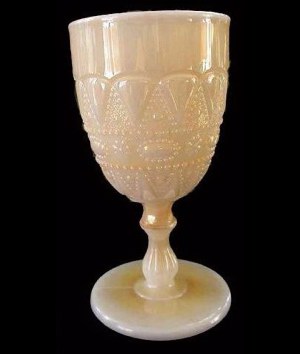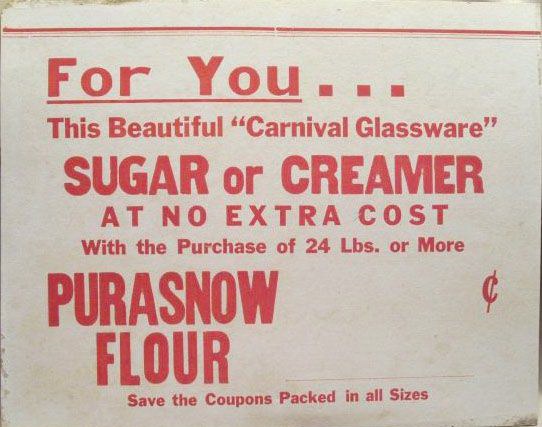Carnival Glass 101 | home Quick Reference to Carnival Glass Patterns on This Site
Novelties - Part 8
NOVELTIES - Part 8

Golfer ashtray
GOLFER ASHTRAY: In the words of Bob Patterson, when he first wrote about the piece in 1998, this ashtray is a “kissin' cousin” to the Polo Ashtray. Polo was discussed by Marion Hartung in the Tenth Book in her Series.
With little notoriety, we must assume it to be scarce-rare! The same size and marigold color as its more familiar cousin, it could accommodate three smokers and hold a box of penny matches.
Bob surmises that the Golfer tray was probably a forerunner of the Polo; reason being: If you look closely at the Polo example, you will see the same motif of golfers and tees around the rim. Only the center is different in design.
The center of the Golfer Ashtray displays what appears to be a woman wearing a pleated skirt and sun hat, with her bag of clubs under one arm, club of choice in the other and in full stride on the golf course.
Both ashtrays are surely from the late carnival/depression era, featuring activities which must have been, at that time, considered only for the well-to-do. Therein may have been the appeal to the buyers of these items.
 |
|
LACY DEWDROP 6 in. Covered Berry Bowl.
|
|
 |
 |
LACY DEWDROP Goblet - 6 in. tall.
|
Lacy Dewdrop. 8.5 in. to knob top. $127.09-eBay-1-08. Quite a price for a (New) item!
|
LACY DEWDROP: For many years, the late Don Moore wrote articles for the GLASS REVIEW. Lacy Dewdrop (also known as Beaded Jewel)---appeared in the July-August, 1981 edition. “Quote: This iridized milk glass is a type of Carnival that is seldom seen. It is often called Pearlized Carnival . This old pressed pattern dates back to the 1880s when it was made in clear glass by the Duncan Glass Co. of Pittsburgh. Since that time the molds have been owned successively by the Cooperative Glass Co., the Phoenix Glass Co., a glass jobber named Tuska and finally by the Kemple Glass Co. When owned by Mr. Tuska the molds were loaned to Westmoreland where they were used to produce milk glass. It is unknown as to when and by whom the few known carnival pieces were iridized.” Don's article displays a water pitcher and tumbler owned by Mike and Jamie Santa of Vacaville, CA at the time the article was written.
Lacy Dewdrop examples have become points of fascination to carnival glass collectors and many auctions feature an example or two. One of the stemmed banana dishes was sold in a Wroda auction we attended in early Dec. 2007. All things considered, the scarce examples which surface within this range of glass, while attractive to many collectors of carnival glass, should still be viewed as novelties. It would require tremendous effort to accumulate enough various shapes to develop a sizable collection.
The goblet shape, tumblers, a water set, stemmed fruit bowl, this large covered bowl, an open compote, as well as a covered compote, cake plate, creamer and covered sugar are additional shapes to be aware of.
Height of the older covered berry bowl with lid in place is 5 ¾”. The bowl is 5 3/8” diameter. It is shown in Hartung's Book 9, page 72, described and advertised in the original old advertising as a 6” “Covered Berry”. Marion Hartung says it is a product of the Cooperative Flint Glass Company of Beaver Falls, PA
This NEW Lacy Dewdrop covered compote is a curiosity; possibly of Chinese descent?

DeVILLBIS Paper label on bottom. 2.75 in. high -Teal Blue
DeVilbiss Perfume: Literally thousands of these lovely containers were made. There are specialty collectors for them, of course, but only a few of them are found iridized. This teal example is so lovely, we decided our viewers would enjoy seeing it.
BUTTER CHURN and its label: This is surely a “first”? Butter is yellow, so why NOT a marigold churn? If not particularly collectable, at least it is a “conversation piece”!

Cardboard sign offering Carnival Glass as a Premium.
Premium Label: It would be nice to know the period in time when this offer was in force. One thing we do know: PURASNOW Flour was still being marketed through the 1940s. Provided the stated offer referred to vintage carnival glass, we just might guess that the offer was valid during the 1930s?

Deflated Bottle having liquor advertising on bottom.
WINE & LIQUOR Bottle: Speaking of conversation pieces………this is not the usual item seen on collectors display shelves either! However, during the time of iridized ginger-ale bottles, why NOT. Believe it or not: it was observing a lady purchasing one of those ginger-ale bottles in an antique store in downtown San Diego in the spring of 1985, which was the determining factor in our initiating the Carnival Glass Club there in June 1985.
We decided that if anyone could be attracted to one of those bottles, there was a need for learning more about REAL carnival glass in that area. We placed notices of the approaching meeting date on bulletin boards in grocery stores, drugstores, the post office, etc. all over town and the outlying areas. 26 eager and very interested new members attended that first get-together held in a community center in Clairemont, just east of Pacific Beach, where we lived. We were up and going from there!

BALTIMORE PEAR Chalice or Celery.
Courtesy Jerry & Carol Curtis
BALTIMORE PEAR Chalice: Jerry and Carol Curtis have an eye for the unusual when they go antiquing. Shown in McCain Pattern Glass, where the piece is stated to be part of an extended table service, it has other pattern names; aka: Gypsy, Fig, Maryland and Twin Pear. Originally produced by Adams & Company, circa 1874 and later by U.S. Glass Company, circa 1891. Circumference of this chalice or celery exceeds 12”. There is no interior lip for a lid cover. The piece is 5” high x 4” deep x 3” base. The pedestal has 8 panels that continue upwards into the bowl of the glass, stopping at the very end of a leaf point. There is no trademark on the piece. Overall ample iridescence covers this well moulded chalice or celery.

BALTIMORE PEAR Covered Candy
BALTIMORE PEAR Covered Candy: While antiquing, 11/19/09, the Curtis' discovered this covered container sitting in a showcase; altering the original thought that the base was not intended to have a cover. With or without a lid, it is an attractive piece.

Westmoreland DOGHOUSE Toothpick.
2.5 x 2.5 x 1.75 x 2.25 inches
DOGHOUSE Toothpick: Said to have been produced by Westmoreland, and may be of a “later than vintage” variety, since Summit Glass has been suggested as a producer, as well. Perhaps some of our viewers know of other colors?

Blank is like GROUND CHERRIES & DAISY & LITTLE FLOWERS.
Photo,Courtesy Greg Lockhart
GROUND CHERRIES/DAISIES & LITTLE FLOWERS Tumbler (Souvenir): The lettering is rather vague, but displays use of the basic tumbler for souvenir lettering rather than the usual decorating with painted cherries. In essence, this provides evidence that Northwood sold “blanks” to the “after-market trade”, as well. Script lettering to commemorate an occasion. “Souvenir………Fair, 1926” is pretty well worn away now, but Greg believes it may say “Indiana Fair.”
Dean & Diane Fry - 2/09
    |
|
The earth is the Lord's, and all its fullness,
the world and those who dwell therein.
For He has founded it upon the seas,
and established it upon the waters.
Who may ascend into the hill of the Lord?
Or who may stand in His holy place?
He who has clean hands and a pure heart,
who has not lifted up his soul to an idol,
nor sworn deceitfully.
He shall receive blessing from the Lord,
and righteousness from the God of his salvation.
This is Jacob, the generation of those who seek Him,
who seek Your face.
Lift up your heads, O you gates!
And be lifted up, you everlasting doors!
And the King of glory shall come in.
Who is this King of glory?
The Lord strong and mighty,
the Lord mighty in battle.
Lift up your heads, O you gates!
Lift up, you everlasting doors!
And the King of glory shall come in.
Who is this King of glory?
The Lord of hosts,
He is the King of glory. ~~~ (Psalm 24)
Taking time each day to reconnect with our heavenly Father is often challenged by the tyranny of the urgent.
However, it is important to look at Jesus' example in making time for prayer despite a busy schedule.
|
|
    |
Should you care to contact the Frys, their email address is:
Search Carnival Glass 101
back to Carnival Glass 101
Our other sites you may enjoy:
Everything you EVER wanted to know about Indiana Glass
Great Reference for Newer Carnival Glass.
Complete Glassware Catalogs Available to Download
Questions? Comments? Suggestions? Broken Links? Corrections?
Your Friendly Webmaster is here to help!


